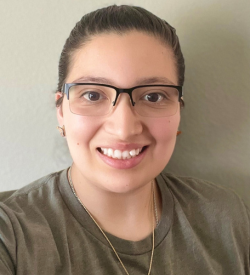Two participants share their journeys to Ph.D. research in biomedical engineering
Clinton Smith, a young Black man from Atlanta, had planned to be a lawyer, but he fell in love with immunology and engineering research as an undergraduate student at the Georgia Institute of Technology. He is now pursuing a Ph.D. in biomedical engineering at the University of Florida, where he is a National Science Foundation Fellow. He plans to have an academic research career.

Mistica Lozano Perez, a young Hispanic woman from San Antonio, was always interested in science. Her plan was to major in biomedical engineering at the University of Texas at San Antonio (UTSA), and then maybe switch to another science, technology, engineering, or mathematics (STEM) field for graduate school. But then she learned what a Ph.D. researcher in biomedical engineering could do and decided to pursue this advanced degree at the University of Pennsylvania. “I plan to stay in academia afterwards and hopefully become a PI (principal investigator) of my own lab,” she said.
Smith and Lozano Perez are among the 259 students who have participated in an NIBIB-funded research education program at their undergraduate institutions called Enhancing Science, Technology, EngineEring, and Math Educational Diversity (ESTEEMED) since it was funded in 2018.
A unique feature of the program is that participants are exposed to hands-on biomedical engineering research in their freshmen and sophomore years. The program also provides mentoring, community-building, educational, and career development activities to prepare participants for academic success in college and to participate in their institutions’ honors programs.
“Ultimately, we would like participants to pursue a Ph.D. or M.D./Ph.D. degree and a subsequent research career integrating engineering and the physical sciences with medicine and biology in academia or industry,” said Zeynep Erim, Ph.D., director of NIBIB’s Division of Interdisciplinary Training.
Participants also have opportunities to interact with underrepresented faculty. “Seeing that it was possible for them to pursue careers in academia opened my mind that I could pursue a similar career path,” said Smith.
NIBIB supports diversity in training
Once they receive their doctorate degrees, Smith and Lozano Perez will fill a diversity gap in the biomedical workforce. The National Science Foundation reported recently that although Black, Hispanic, American Indian, or Alaska Native people represent 31% of the U.S. population, they make up only 24% of the STEM workforce. Undergraduate STEM students from these racial and/or ethnic groups are more likely to drop out of college and/or change to non-STEM majors than white STEM students, according to a study in the Educational Researcher.
NIBIB supports the NIH mission of making the scientific workforce more inclusive. A benefit of diversity is having a full range of talent, which fosters greater creativity and innovations in science, according to the NIH Chief Officer for Scientific Workforce Diversity Strategic Plan.
“We all know that talent is everywhere, but opportunity is not,” said Tina Gatlin, Ph.D., program manager of the ESTEEMED program and a program director in NIBIB’s Division of Interdisciplinary Training.
“ESTEEMED is designed to help underrepresented students remain in STEM, obtain a STEM college degree, and to ultimately proceed to pursue doctoral degrees in biomedical engineering or STEM fields relevant to NIBIB’s scientific mission,” said Gatlin.
Since 2018, 15 universities and colleges have established ESTEEMED programs; seven are low-resourced, including two historically black colleges and universities (HBCUs), according to Gatlin. Three institutions, including UTSA are designated as “Hispanic-Serving Institutions” with a minimum of 25% Hispanic student enrollment, she noted.
ESTEEMED participants get a head start on STEM classes with a summer bridge program followed by two years of educational activities and bioengineering research experiences.
“ESTEEMED really helped prepare me for my STEM classes and kept me on track with my biomedical engineering degree by giving me support and new skills. It also gave me a lot of confidence in myself and that I could accurately interpret the research data and present my research at conferences—something I never thought I would do!” Lozano Perez said.
The difference mentors make
Manu O. Platt, Ph.D., director of NIBIB’s Center for Biomedical Engineering Technology Acceleration (BETA), was one of Smith’s mentors at Georgia Tech. He was a professor of biomedical engineering there and director of the university’s ESTEEMED program.

“Seeing that Dr. Platt was a very successful Black professor on the Georgia Tech faculty was inspiring,” said Smith. “He saw something in me and provided a lot of encouragement and feedback on my presentations.” He also made himself very available to all ESTEEMED students, attended their meetings, and wrote recommendation letters, said Smith.
He knew Platt from when he participated in a program that Platt co-founded designed to interest Black high school students in biomedical engineering. Smith had a paid summer research internship at Georgia Tech.
“When I think about Clinton Smith and students like him -- students that have always been stars and with limitless potential -- all they needed was opportunity,” said Platt. “Clinton will jump on every opportunity that you put in front of him and do it with excellence. That makes me so proud! I saw that in him as a 15-year-old high school student and I see that in him as a 23-year-old graduate student,” said Platt, who is also a senior investigator and the associate director for Scientific Diversity, Equity, and Inclusion at NIBIB.
Platt added, “Someone also saw that in me. If more of us could see and reward potential and hunger with opportunity, then we would generate a whole lot more innovative scientists and engineers in this country.”
Lozano Perez also developed a relationship with her mentor Teja Guda, Ph.D., the Jacobson Distinguished Professor of Innovation and Entrepreneurship at UTSA. She spent four years in his research lab learning about tissue engineering and regenerative medicine.
“Mentorship for me is allowing students the freedom within that research experience to explore what they truly like or dislike, especially someone like Mistica who was exceptionally enthusiastic about everything,” said Guda. “The fact that she made the most of these opportunities, excelled at all the projects she took on and is now thriving in her continuing journey in biomedical research is purely a reflection of Mistica herself.”
Lozano Perez said, “I am glad the program paired me with him. In addition to research experience, he was helpful in giving me advice about which classes to take and even what graduate schools to apply to. He also let me know about research conferences and other opportunities I wouldn’t have known about. Because of him, I was able to meet a lot of professionals in the orthopedic field,” she said.
Getting through challenging times
Smith, who went to an all-Black high school in Atlanta, had a very different experience at Georgia Tech where he was often the only Black student in his biomedical engineering classes. “That was jarring and challenging. I felt uncomfortable in those settings and my grades suffered early on, which affected my confidence,” he said.
Smith knew that the six other participants in the ESTEEMED program at Georgia Tech were having similar experiences and they turned to each other for support.
Platt also encouraged Smith to stick with it, having had a similar experience—he went to a HCBU and then to Georgia Tech for his Ph.D. in biomedical engineering. “He reminded me that I deserved to be there just as much as the other students did and that I am capable of accomplishing the same things despite being the only Black person there,” said Smith.
He eventually found his stride and learned to embrace some of the discomfort he felt about being a minority. “I can rely on my experiences at Georgia Tech to get me through a lot of different challenges.”
Lozano Perez struggled with what she calls “imposter syndrome,” the feeling that she doesn’t deserve to be there. “There were moments when I wanted to drop out. That’s when you just need someone to remind you that you’re here for a reason and that you have accomplished so many things already,” she said.
Having a lot of people in her corner to support her, including Guda and the ESTEEMED program director Gail Taylor, Ph.D., gave her the confidence to see how far she could go as an undergraduate.
Lozano Perez is now applying her passion to her graduate school experience. “I am glad I have the love for science and want to be in the research lab. I want to be on the front line of groundbreaking science and say oh, look at what we did!”
